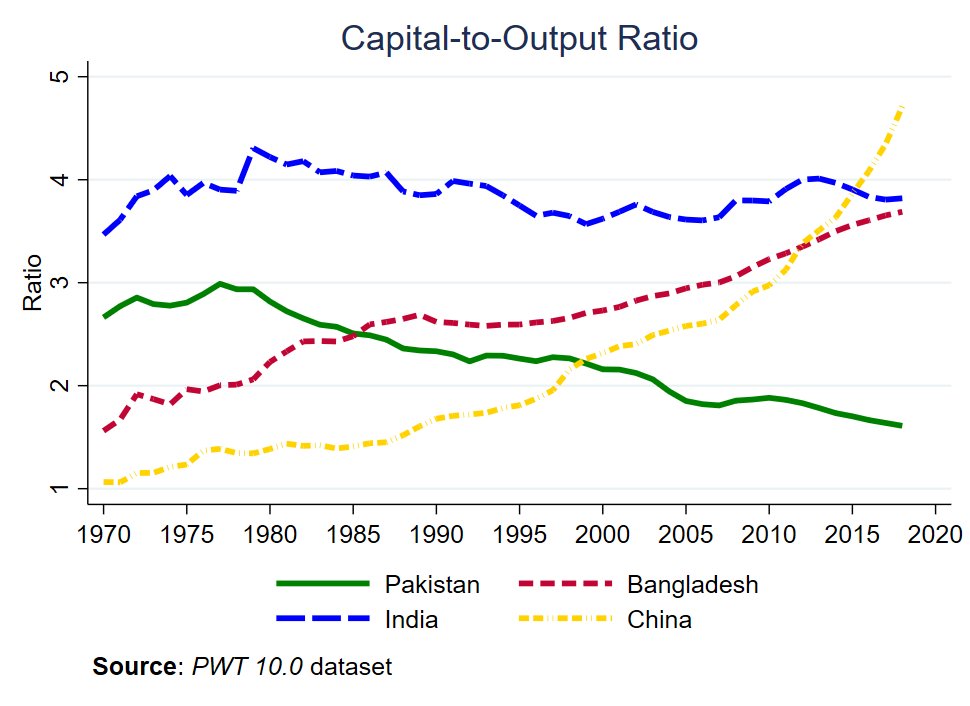(1/n) To ans questions raised in comments to my earlier post, let me explain y I hav a serious issue with this graph. Note that the graph DEFINES that anyone earning more than $300 per month belongs to middle class. This is exactly wat is wrong with it. Y? 
https://twitter.com/ajpirzada/status/1312552425287487488?s=20

(2/n) In short, bec purchasing power of $ has continued to change over time. Let's start frm 2014. Recall that while exchange rate remained almost fixed between 2014-18, domestic prices kept increasing by more than increase in world prices. Result: real exchange rate appreciated.
(3/n) Now the graph. A person earning $300 in 2014 does not hav same purchasing power as one earning $300 in 2017. In fact, one earning $300 in 2017 is poorer than one earning $300 in 2014. Y? Bec, due to overvaluation in exch rate, $1 buys u less in 2017 than wat it did in 2014.
(4/n) We can now appreciate the problem with this graph. By focussing on $ income instead of real income, it exaggerates the increase in middle class btw 2014-17. Many still earning $300 or so in 2017 r actually worse off than before & shud be excluded frm middle class definition
(5/n) The opposite happens during latter part of the graph. Real exchange rate devalued by 25% between Jun-17 & Jun-19 (SBP data). Meaning, $1 buys u more in 2019 than wat it did in 2017. In other words, someone earning $300 in 2019 is better off than someone earning $300 in 2017
(6/n) So, if the point of reference is 2017/18, then many who r earning even less than $300 in 2019 shud be part of the middle class. In short, the graph exaggerates both the increase in middle classes between 2014-17 & also the decrease between 2018-19. I hope it is clear now.
(7/n) To get a much better picture one shud look at real income (actual income adjusted for infl) rather than nominal income. Let's look at HIES surveys which provide data for year 2015-16 & 2018-19. First thing to note is wages only account for less than half of total HH income. 



(8/n) It turns out nominal income of HHs in 2nd, 3rd & 4th quintile increased by 21%, 11% & 11%, respectively. Price level over this period also increased by 16% (SBP). This implies an increase in real income of 5% for HHs in 2nd quintile but a decrease of 5% for HHs in 3rd & 4th
(9/n) The numbers r quite far away frm the exaggerated picture presented in the original graph. And the reason for this is the focus on $ income rather than real income. Note, we still dont hav data for FY20 & I am sure things wont look pretty. But HIES surveys also hav problems.
(10/n) If you look at tables in (7/n), you'll find out that the average HH real income has not changed at all between 2016-19. But we know that the GDP per capital has increased between this period. Average HH income should reflect this unless ...
(11/n) ... a 'significant' part of annual income belonged to foreign companies which sent it back to their home countries in the form of profit repatriation. Can this explain the difference between HIES surveys and aggregate macro data? I dont know!
(n/n) To conclude, the mistake I am trying to highlight is the same mistake which people make when saying that GDP has decreased bec it is now worth less in $ terms. Please dont make this mistake of analysing economic activity in nominal terms. In most cases, do so in real terms!
• • •
Missing some Tweet in this thread? You can try to
force a refresh












